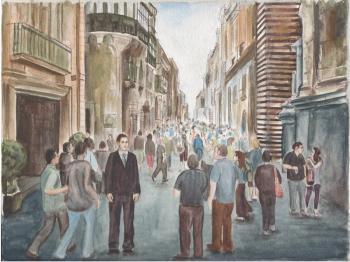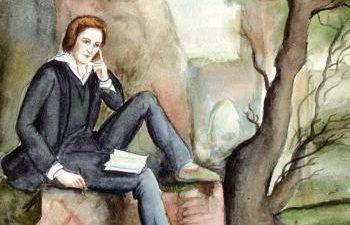And all at once, as there we sat, we heard A cracking and a riving of the roofs, And rending, and a blast, and overhead Thunder, and in the thunder was a cry. And in the blast there smote along the hall A beam of light seven times more clear than day: And down the long beam stole the Holy Grail All over covered with a luminous cloud, And none might see who bare it, and it past. But every knight beheld his fellow’s face As in a glory, and all the knights arose…

How many of us long for an epiphany—some flash of insight to redeem the dull succession of identical hours. Time passes and nothing happens. No inspiration strikes, no light falls. And yet we still like to believe there could be, at any moment, some sign or wonder that could make all the difference between existing and truly living. In the meantime, we flicker between thought and action, hope and boredom, dream and reality.
It is this state of indeterminacy that Tennyson evokes so brilliantly in his poetry. He is the poet of the borderline: the poet of mist, magic, and mania too. His character the Lady of Shalott spends her life on a silent and remote isle, gazing at shadows of the world in her enchanted mirror. Mariana in her moated grange pines for her lover, while yearning for oblivion. The Lotos Eaters, chewing on their drug of choice, tempt Ulysses’s sailors to turn on, tune in, and zone out.
But sometimes the borderline is crossed. The results are cataclysmic or sublime. When the Lady of Shalott, for instance, tries to escape from her delightful prison, she is struck down by a curse; and in this passage from “Idylls of the King,” the knights of King Arthur’s court, pining for a glimpse of the Holy Grail, are blessed by a supernatural visitation. Thunder rolls, the roof of Camelot is ripped off, and light pours through. It’s uncertain whether this vision comes from heaven or hell.
As we read and re-read the passage, it’s as if time slows down. Everything drops away. All is shock and awe, destruction and majesty.
This is poetry as imaginative spectacle. It should inspire less of a disaffected shrug of the shoulders or thoughtful “I wonder what that means?” and more of a breathless “Wow.” For modern-day comparisons, we need to look to cinema: the opening of the “Ark of the Covenant” in the first and best Indiana Jones film, for instance, or scenes in “Star Wars” or “The Matrix.”
But what exactly is or was the Holy Grail? In Tennyson’s words, it was “The cup, the cup itself, from which our Lord/ Drank at the last sad supper with his own.” According to legend, it was taken to Glastonbury in England after Christ’s crucifixion by the mysterious Joseph of Arimathea and was discovered to have miraculous powers: “If a man/ Could see or touch it, he was healed at once/ By faith of all his ills.” When the times turned evil, it disappeared, leaving generations to pray for its return.
Now, suddenly, it has reappeared. But covered in a “luminous cloud,” it cannot be discerned. Its purity can only be seen reflected in the faces of the knights themselves. This suggests that while God cannot be looked at directly, he can be perceived through the glory of creation. As one, the knights arise as the Grail vanishes, their hearts aching to pursue it to the ends of the earth.
As Tennyson relates the story, the knights ride off in search of the Grail, but they all fail in their quest. Lancelot, Sir Percivale, Sir Galahad—they return broken by the knowledge of their own sinfulness, the final barrier between them and what they seek. Darkness falls on Camelot and the age of heroes. Only one person sees the Grail: not a knight, not a warrior, but a nun whose soul has been sanctified by long spiritual struggle.
What can we draw from this? The Holy Grail is something that delights and torments, guides and perplexes, promises enlightenment and brings hideous darkness. It is the ideal that devastates mere reality, the vision that turns each ordinary day to ash—and yet from that ash forms a heavenly image. Without such dreams, realized only by the very few, what would we strive for?
Alfred Tennyson (1809–1892) was poet laureate of the UK, famous for poems like “The Lady of Shalott,” “The Lotos Eaters,” and “Maud.”




